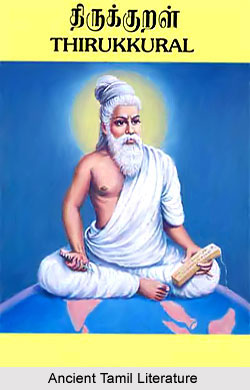 Ancient Tamil literature can be traced back to the pre-Christian epoch and there was minimal influence of other literatures and languages on the Tamil nation. The initial Tamil poetical forms were mainly inspired from folk songs. Tamil literature, which spanned over 12 centuries, had originated before the advent of literary works in other Dravidian languages that came into existence after 8th Century AD. In the Sangam Literatures (500 B.C.-200 A.D), no clear mention can be found of Kannada, Telugu and Malayalam languages. The inhabitants that resided beyond the Tirupati Hills wre identified as Vatukar and Kerala is referred to as Cera Nadu in the Sangam classics. The inhabitants of the region studied poems in Tamil and composed Tamil poetical works.
Ancient Tamil literature can be traced back to the pre-Christian epoch and there was minimal influence of other literatures and languages on the Tamil nation. The initial Tamil poetical forms were mainly inspired from folk songs. Tamil literature, which spanned over 12 centuries, had originated before the advent of literary works in other Dravidian languages that came into existence after 8th Century AD. In the Sangam Literatures (500 B.C.-200 A.D), no clear mention can be found of Kannada, Telugu and Malayalam languages. The inhabitants that resided beyond the Tirupati Hills wre identified as Vatukar and Kerala is referred to as Cera Nadu in the Sangam classics. The inhabitants of the region studied poems in Tamil and composed Tamil poetical works.
Influence of Sanskrit on Ancient Tamil Literature
During the 7th Century AD, Tamil scholars who resided in the urban regions made contact with Sanskrit scholars and gradually Sanskrit words, such as Anai (command), Karanam (reason), Teyvam (God), were included in the Tamil vocabulary. Further more, with the expansion of Buddhism and Jainism, more such words of North Indian languages gained prominence in Tamil. The influence of Sanskrit on Tamil literature eventually augmented as the Buddhists and Jains were experts in Sanskrit, Pali and Prakrit. This marked the advent of Sanskrit words in Tamil and the followers of Buddhism and Jainism were mainly responsible for this.
During this era, only two major languages, Sanskrit and Tamil, were considered as literary languages. Sanskrit was regarded as the language of the North and Tamil was the language of the South. Tamil was identified as Dravidian by the Sanskrit scholars. According to the Puranas, Lord Shiva taught Tamil to Agastya and Sanskrit to Panini. Thus it is considered that only Sanskrit and Tamil prevailed during the earliest Indian literary history.
Emergence of Manippravala
Numerous Sanskrit Puranas were converted into Tamil during this period. Gradually scholars realised both Sanskrit and Tamil scholars operated as 2 separate groups in a solitary cultural environment. Thus the scholars of Sanskrit and Tamil attempted to unite both languages and invented a unique hybrid style of writing known as Manippravala. In this new fusion style both Tamil and Sanskrit words were utilised equally. Some Jain and Vaisnavite took efforts to propagate this distinctive style by constructing literary works in Manippravala as they thought that it would increase understanding between Sanskrit and Tamil scholars and encourage unity.
Certain Tamil works were written in Manippravala style and Sanskrit works were composed in Grantha script. But a few scholars were unable to modify the tone of a language. Thus the Manippravala style of writing became unsuccessful to promote evolution and development amongst the scholars. Distinguished poets, such as Kampar and eminent commentators of Tamil literature and grammatical texts, discarded this style. Instead the focus on the traditional features of the Tamil language increased further. Thus certain scholars used minimal Sanskrit words while others attempted to amplify the use Sanskrit vocabulary in Tamil. Finally their efforts accomplished to preserve Tamil words and Tamil sounds.
Influence of Other Languages on Ancient Tamil Literature
During the late 9th Century AD, the Pallava dynasty disintegrated and the Cholas re-appeared and became the supreme power. The Cholas ruled the Tamil nation upto 13th Century, after which they also collapsed. The Muslims invaded the entire country which affected the Tamil land as well. During the reign of the Vijayanagar Empire, the Nayak kings became popular in Tamil Nadu. Due to the political standing of the Telugus, their collaboration with Tamils improved in several activities. Various works like Pirapulinkalilai and others were translated into Tamil and few devotional poems of Alvars were also converted into Telugu. Tamil biographies of Saiva saints were further translated into Kannada. These literary works resulted in a better understanding of the Dravidian languages of the South.
During the rule of Saraboji rulers of Maharashtra in the Tamil land of Thanjavur, few Marathi words were also introduced in the colloquial Tamil. With the advent of the Nawabs of Carnatic, some Persian and Arabic words formed part of the Tamil administrative vocabulary. Moreover, there was also strong influence of European languages on Tamil since the 17th Century. With improvements in technology and use of printing machines, volume of prose works augmented. Through the English, western literary genres, such as novel, plays, short story were introduced in Tamil literature.
As the Tamil nation had been politically dominated by various foreign forces until 1947, the influence of various dynasties and cultures have been significant in the development of Tamil literature and language.



















